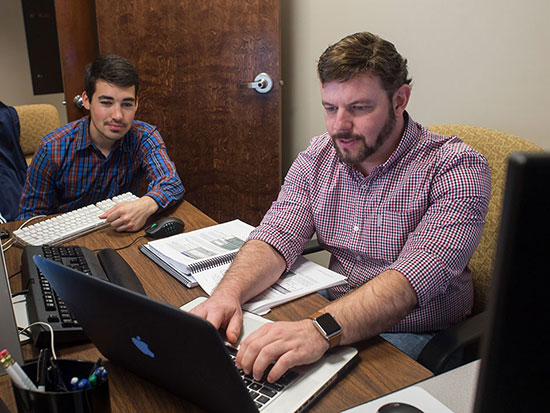Media contact: Yvonne Taunton
 Shawn Sharp (right)For as long as he can remember, UAB junior Shawn Sharp has been drawn to both computers and crimefighting.
Shawn Sharp (right)For as long as he can remember, UAB junior Shawn Sharp has been drawn to both computers and crimefighting.
His father became a police officer after a stint in the military, and his stepfather served as Birmingham’s deputy chief of police. As a kid, long before he ever owned his own computer, Sharp was enthralled by “The Cuckoo’s Egg,” a nonfiction account of a lone systems administrator’s efforts to track down a German hacker, and “Ghost in the Wire,” the autobiography of hacker Kevin Mitnick. Today, when he’s not in class, he can often be found at UAB’s Translational Research for Injury Prevention (TRIP) Laboratory, where he programs scenarios for the lab’s state-of-the-art driving simulator. “I guess both computing and crime prevention are in my blood,” Sharp says.
Sharp already had planned to enter UAB’s highly regarded Master of Science in Computer Forensics and Security Management program after he graduated. “It’s a field that I’ve wanted to work in for a long time,” he says. So when he learned that UAB was launching a new undergraduate major in digital forensics this spring, Sharp quickly switched his degree. “Having always had a high interest in technology as well as law enforcement, digital forensics seemed a natural fit,” he says.
Like the master’s program, the undergraduate digital forensics major is interdisciplinary, taught by faculty from the departments of Justice Sciences and Computer and Information Sciences, both in the UAB College of Arts and Sciences. “The goal is to provide students with the tools they need in computer programming [as well as] an understanding of the legal system and processes necessary to gather digital evidence and support a computer investigation in court if necessary,” says Jeffrey Walker, Ph.D., chair of the Department of Justice Sciences.
Students will learn how to discover, recover, analyze and present information from any digital device, whether it’s an industrial mainframe computer system or a disposable “burner” phone used in the drug trade. (The prosecution of Bernie Madoff, for instance, turned on careful digital forensic work with a decades-old IBM minicomputer that the disgraced investor had used to perpetrate fraudulent stock market trades.) Students must also complete an internship in a federal, state or local law enforcement agency, or a cybersecurity post in the business world, from Regions to Facebook, Google or Walmart.
Job growth in the field is well above average, according to projections from the U.S. Department of Labor. Within the next decade, more than 100,000 jobs are expected to become available in cybersecurity and digital forensics. “Both hold my interest,” says Sharp, “and I would be extremely happy doing either one as a career.”